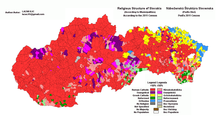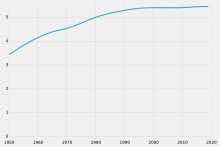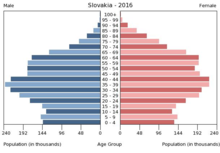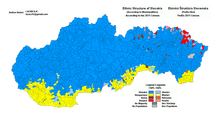Slovakia
![]()
This article is about the Slovak Republic, which came into being in 1993; for Slovakia in the years 1939 to 1945, see Slovak state.
Template:Infobox State/Maintenance/NAME-German
Slovakia (Slovak ![]() , officially Slovak Republic, Slovak
, officially Slovak Republic, Slovak ![]() ) is a landlocked country in Central Europe, bordering Austria, the Czech Republic, Poland, Ukraine and Hungary. The capital and largest city of the country is Bratislava (German Pressburg), other important cities are Košice (Kaschau), Prešov (Eperies), Žilina (Sillein), Banská Bystrica (Neusohl) and Nitra (Neutra).
) is a landlocked country in Central Europe, bordering Austria, the Czech Republic, Poland, Ukraine and Hungary. The capital and largest city of the country is Bratislava (German Pressburg), other important cities are Košice (Kaschau), Prešov (Eperies), Žilina (Sillein), Banská Bystrica (Neusohl) and Nitra (Neutra).
The country is two-thirds mountainous and has a considerable share of the Carpathian arc. In the west, it extends to the part of the Vienna Basin lying north of the Danube, while the south and southeast, as far as the Danube and a small part of the Tisza, are dominated by foothills of the Pannonian Plain. Slovakia lies in the continental-temperate climate zone with differences between the low-lying south and the mountainous north of the country.
The territory of present-day Slovakia was settled by the Slavs at the turning point of the 5th and 6th centuries. Their first political entity was the Empire of Samo (7th century), and later Slovakia was one of the centres of the early medieval Moravian Empire. In the 11th century Slovakia was incorporated into the Kingdom of Hungary, which was part of the Habsburg Monarchy from 1526 and part of Austria-Hungary from 1867. After the dissolution of the Dual Monarchy in 1918, Slovakia became part of the newly formed Czechoslovakia. With its breakup by the German Reich, the short-lived Slovak State was created in 1939. After the end of World War II, the Czechoslovak Republic was restored in 1945. On 1 January 1993, after the peaceful partition of Czechoslovakia, the independent Slovak Republic came into being as a national state of the Slovaks.
Slovakia has been a member of the European Union and NATO since 2004. In 2007, under the Schengen Agreement, border controls with EU countries were lifted, and in 2009 Slovakia joined the eurozone. The country is a democratic parliamentary republic. Together with Poland, the Czech Republic and Hungary, Slovakia forms the Visegrád Group.
The United Nations Development Programme ranks Slovakia among the countries with very high human development.
State name and ethnonym
→ Main article: Slovaks - name and Upper Hungary
Historical
The current German name of the territory and state, Slovakia, is relatively new and first appeared in a petition to the Austrian Emperor in 1849. The Slovak national designation Slovensko has been documented in writing since the 15th century, and derived from the Old Slavic self-designation of all Slavs, the Sloveni, which appeared as early as the 9th century. In the 14th century, the territory of present-day western and central Slovakia was often referred to as "Matúšová zem" (Slovak: Matúšová land), after the powerful Magyar prince Matúšová Csák. From the 16th century onwards, the name Upper Hungary (Slovak: Horné Uhorsko) was increasingly used for the territory of present-day Slovakia, after most of Hungary, except for present-day Slovakia, was under Turkish rule.
Similarities of the state names of Slovakia and Slovenia
The present self-designation of the West Slavic Slovaks, like that of the South Slavic Slovenes, is derived from the original designation of all Slavs, the Sloveni. Thus the Slovaks refer to their country as Slovensko, while Slovenia is called Slovenija by the Slovenes. The Slovak language is called slovenčina in Slovak, while the Slovene language is called slovenščina in Slovenian. The word for Slovak (in Slovak) and Slovene (in Slovenian) is the same in both languages: Slovenka. The only major difference today is in the masculine form: While the original masculine form Slovenec has survived among Slovenes to the present day, a reshuffle occurred among Slovaks in the 15th century (under Czech and Polish influence), when the original masculine term Sloven was replaced by the present-day term Slovák.
Population
The country has about 5.46 million inhabitants (as of 2019). Population development has been rather stagnant since independence. Life expectancy in the period from 2015 to 2020 was 77.3 years (men: 73.7 years, women: 80.8 years), the average age 41.2 years (as of 2020), whereby an increasing ageing of the population can be observed.
Breakdown by nationality and citizenship
Censuses in Slovakia distinguish between 'nationality' (Slovak: národnosť) in the sense of ethnic ethnicity and 'citizenship' (Slovak: štátne občianstvo). The data on ethnic nationality are based on the self-classification of the population and include all persons with permanent residence on Slovak territory. The ethnic structure is likely to differ from the results. This is particularly true for the proportion of Roma, which is estimated to be much higher than in official statistics. The so-called "Atlas of Roma Communities", year 2013 gives an estimate of 402,840 Roma (about 7.5%), while Amnesty International estimates the number to be between 300,000 and 600,000, which would correspond to 5 to 10% of the population. There were gross inaccuracies in the last census in 2011 in particular. The Slovak Roma expert Martin Šuvada (2015) estimates the total number of Slovak Roma in his study at 450,000 people. It is clear that the number of Roma continues to rise due to the high birth rate and that the figure will have to be adjusted upwards in the future. The Roma are the only nationality in Slovakia that does not declare its ethnicity in the majority of censuses.
The "Statistical Office of the Slovak Republic" (Štatistický úrad Slovenskej republiky, ŠÚ SR) provided the following data for the 5,443,100 inhabitants in 2017 (seven main countries):
| Citizenship | Share (%) | Number |
| Slovakia | 98,66 | 5.370.237 |
| Czech Republic | 0,25 | 13.525 |
| Hungary | 0,19 | 10.248 |
| Romania | 0,12 | 6.521 |
| Poland | 0,11 | 5.758 |
| Germany | 0,08 | 4.083 |
| Ukraine Ukraine | 0,06 | 3.482 |
At the same time, the Statistical Office stated the following about the ethnic composition: Slovaks (81.5%), Magyars (8.3%), Roma (2%), Czechs (0.7%), Russians (0.6%), Ukrainians (0.2%), Germans (0.1%), Poles (0.1%) and others including those not specified (6.4%).
| Population of Slovakia by nationality | ||||||
| Census 2011 | 2001 census | 1991 census | ||||
| Nationality | Number | % | Number | % | Number | % |
| slovak | 4.352.775 | 80,7 | 4.614.854 | 85,8 | 4.519.328 | 85,7 |
| Magyar | 458.476 | 8,5 | 520.528 | 9,7 | 567.296 | 10,8 |
| romani | 105.738 | 2,0 | 89.920 | 1,7 | 75.802 | 1,4 |
| russian | 33.428 | 0,6 | 24.201 | 0,4 | 17.197 | 0,3 |
| czech | 30.367 | 0,6 | 44.620 | 0,8 | 52.884 | 1,0 |
| ukrainian | 7.430 | 0,1 | 10.814 | 0,2 | 13.281 | 0,3 |
| German | 4.690 | 0,1 | 5.405 | 0,1 | 5.414 | 0,1 |
| Moravian | 3.286 | 0,1 | 2.348 | 0,0 | 6.037 | 0,1 |
| polish | 3.084 | 0,1 | 2.602 | 0,0 | 2.659 | 0,1 |
| Russian | 1.997 | 0,0 | 1.590 | 0,0 | 1.389 | 0,0 |
| Bulgarian | 1.051 | 0,0 | 1.179 | 0,0 | 1.400 | 0,0 |
| croatian | 1.022 | 0,0 | 890 | 0,0 | n.a. | n.a. |
| serbian | 689 | 0,0 | 434 | 0,0 | n.a. | n.a. |
| Jewish | 631 | 0,0 | 218 | 0,0 | 134 | 0,0 |
| other | 9.825 | 0,2 | 5.350 | 0,1 | 2.732 | 0,1 |
| not determined | 382.493 | 7,0 | 54.502 | 1,0 | 8.782 | 0,2 |
| Total | 5.397.036 | 100 | 5.379.455 | 100 | 5.274.335 | 100 |
Slovakia is described - similar to Israel and some other European and Asian states - as an ethnic democracy with a "constitutional nationalism" in which "the dominance of one ethnic group is institutionalized". The preamble of the Slovak Constitution expresses the ethnonational ideological basis of the Slovak Republic:
"We, the Slovak people, in remembrance of the political and cultural heritage of our forefathers and of the centuries of experience gained in the struggles for national existence and for our own statehood, in the spirit of the spiritual heritage of Kyrillios and Methodios and of the historical legacy of the Great Moravian Empire, proceeding from the natural right of peoples to self-determination, together with the members of national minorities and ethnic groups living in the territory of the Slovak Republic, in the interest of lasting peaceful cooperation with the other democratic states, in an effort to enforce a democratic form of government, guarantees for a free life, the development of spiritual culture and economic prosperity, we, the citizens of the Slovak Republic, through our representatives, adopt this Constitution: […].“
This preamble defines the Slovak people as the people of the state. Thus, the preamble emphasizes sovereignty not on the basis of citizens, but on the basis of the Slovak nation. While the Slovak Constitution prohibits any discrimination against minorities and guarantees them the right to organize and the possibility of cultural self-determination, at the same time it functions as an instrument for establishing the unrestricted rule of the majority. The rights of minorities "shall not endanger the sovereignty or territorial integrity of Slovakia or cause discrimination against the rest of the population". The Slovak Constitution of 1992 thus clearly signals, according to Robert J. Kaiser's assessment in 2014, that "Slovakia for the Slovaks" is the basis on which the nation-state will be constructed.
Languages
See also: Slovak language, Slovak grammar and Slovak alphabet
According to Art. 6 of the Constitution of the Slovak Republic, Slovak is the state language and belongs to the West Slavic branch of the Slavic languages, together with Kashubian, Polish, Sorbian and Czech. Slovak is a highly inflectional language with six grammatical cases and is divided into three major dialect groups: West Slovak, Middle Slovak, and East Slovak. The orthography is based on the Latin alphabet and contains a total of 46 letters, 17 of which have diacritical marks and three digraphs. The current written language has its basis in Central Slovak dialects and was codified by Ľudovít Štúr in 1846. With Slovakia's accession to the EU on 1 May 2004, Slovak also became one of the official languages of the European Union.
Hungarian is widespread in southern Slovakia, while Russian is mainly found in northeastern Slovakia in the area of the Lower Beskids. Romani is often spoken in Roma communities, German as an autochthonous language has almost disappeared since 1945 except for smaller language islands. Due to the common coexistence in Czechoslovakia as well as linguistic similarities, Slovaks can usually understand Czech without any problems. Even after the separation, a high level of understanding is ensured mainly through Czech-language television, although the younger generation may have difficulties communicating. According to a representative survey conducted by Eurobarometer in 2012, 26% of Slovaks have sufficient knowledge of English to hold a conversation, followed by German at 22% and Russian at 17%. English, German, Italian, French, Spanish and Russian are offered in primary schools, with the first foreign language introduced as a compulsory subject in the third grade. If the first foreign language is not English, it becomes the second foreign language as a compulsory subject from the seventh grade onwards.
See also: Magyars in Slovakia, Carpathian Germans and Roma in the Czech Republic and Slovakia
According to the law, minority localities are those localities in which a non-Slovak population group reached at least 20% of the total population in two or more censuses. In these localities, the minority language is used as a second official language, and inscriptions on public buildings are also made in two languages. For example, in the Central Slovak municipalities of Krahule (German Blaufuß) and Kunešov (Kuneschhau), German is considered the second official language. In 2011, against the will of the opposition parties, a law was passed reducing the percentage to 15%. In addition to German, these languages are Hungarian, Czech, Bulgarian, Croatian, Polish, Romani, Ruthenian and Ukrainian.
| Population of Slovakia by language according to 2011 census | ||||||
| by native language | in house language | by lingua franca | ||||
| Language | Number | % | Number | % | Number | % |
| slovak | 4.352.775 | 78,6 | 3.954.149 | 73,3 | 4.337.695 | 80,4 |
| hungarian | 508.714 | 9,4 | 472.212 | 8,7 | 391.577 | 7,3 |
| romani | 122.518 | 2,3 | 128.242 | 2,4 | 36.660 | 0,7 |
| russian | 55.469 | 1,0 | 49.860 | 0,9 | 24.524 | 0,5 |
| ukrainian | 5.689 | 0,1 | 2.775 | 0,1 | 1.100 | 0,0 |
| czech | 35.216 | 0,7 | 17.148 | 0,3 | 18.747 | 0,3 |
| German | 5.186 | 0,1 | 6.173 | 0,1 | 11.474 | 0,2 |
| polish | 3.119 | 0,1 | 1.316 | 0,0 | 723 | 0,0 |
| croatian | 1.234 | 0,0 | 932 | 0,0 | 383 | 0,0 |
| Yiddish | 460 | 0,0 | 203 | 0,0 | 159 | 0,0 |
| Bulgarian | 132 | 0,0 | 124 | 0,0 | 68 | 0,0 |
| other | 13.585 | 0,3 | 34.992 | 0,7 | 58.614 | 1,1 |
| not determined | 405.261 | 7,5 | 728.910 | 13,5 | 515.312 | 9,5 |
| Total | 5.397.036 | 100 | 5.397.036 | 100 | 5.397.036 | 100 |
Religions
→ Main article: Religions in Slovakia
Slovakia is a country with a long Christian tradition. The most important denomination is the Roman Catholic Church, to which 62 % of the population professed in 2011. The centre of Lutheran Christians are the western border areas with the Czech Republic and especially central Slovakia; the Reformed population is concentrated in the Hungarian-speaking area in the south. Greek Catholics live in the northeast of the country, mainly members of the Ruthenian minority. The Orthodox Church has 49,000 members. There are also several small Protestant denominations (Methodists, Baptists, Brethren and Pentecostals). There are also Jehovah's Witnesses, Seventh-day Adventists and others.
In 1938, there were still about 120,000 Jews in Slovakia, but as a result of the Holocaust and emigration during communism, their number has dropped to about 2,300. The official number of Muslims in Slovakia is not known, as Islam was not a separate category in the 2011 census. The number has increased in recent years due to migration. Along with Estonia, Slovakia is the only state within the European Union without a mosque. A 2016 tightening of the religion law set the minimum number of members of a new religious community to be registered at 50,000, making it almost impossible for Muslims to be recognized. According to the spokesman for the Islamic Centre in Bratislava, Ibrahim Mahmoud, there are currently around 5,000 Muslims living in the Slovak Republic, but they belong to different faiths and do not feel represented by anyone.
According to a representative survey conducted by Eurobarometer, 63% of people in Slovakia believed in God in 2010, while another 23% believed in a spiritual force only to a certain extent. 13 % of respondents believed neither in a God nor in another spiritual force, 1 % of Slovaks were undecided.
| Population of Slovakia by religious denomination | ||||||
| Census 2011 | 2001 census | 1991 census | ||||
| Religion | Number | % | Number | % | Number | % |
| Roman Catholic Church | 3.347.277 | 62,0 | 3.708.120 | 68,9 | 3.187.120 | 60,4 |
| Evangelical Church A. B. | 316.250 | 5,9 | 372.858 | 6,9 | 326.397 | 6,2 |
| Greek Catholic Church | 206.871 | 3,8 | 219.831 | 4,1 | 178.733 | 3,4 |
| Reformed Churches | 98.797 | 1,8 | 109.735 | 2,0 | 82.545 | 1,6 |
| Orthodox Church | 49.133 | 0,9 | 50.363 | 0,9 | 34.376 | 0,7 |
| Jehovah's Witnesses | 17.222 | 0,3 | 20.630 | 0,4 | 10.501 | 0,2 |
| Evangelical Methodist Church | 10.328 | 0,2 | 7.347 | 0,1 | 4.359 | 0,1 |
| Kresťanské zbory (Christian communities in Slovakia) | 7.720 | 0,1 | 6.519 | 0,1 | 700 | 0,0 |
| Apostolic Church | 5.831 | 0,1 | 3.905 | 0,1 | 1.116 | 0,0 |
| Baptist brotherly unity | 3.486 | 0,1 | 3.562 | 0,1 | 2.465 | 0,0 |
| Brethren Movement | 3.396 | 0,1 | 3.217 | 0,1 | 1.867 | 0,0 |
| Seventh-day Adventists | 2.915 | 0,1 | 3.429 | 0,1 | 1.721 | 0,0 |
| Judaism | 1.999 | 0,0 | 2.310 | 0,0 | 912 | 0,0 |
| Czechoslovak Hussite Church | 1.782 | 0,0 | 1.696 | 0,0 | 625 | 0,0 |
| Old Catholic Church | 1.687 | 0,0 | 1.733 | 0,0 | 882 | 0,0 |
| Bahaitum | 1.065 | 0,0 | n.a. | n.a. | n.a. | n.a. |
| Church of Jesus Christ of Latter-day Saints | 972 | 0,0 | 58 | 0,0 | 91 | 0,0 |
| New Apostolic Church | 166 | 0,0 | 22 | 0,0 | 188 | 0,0 |
| other | 23.340 | 0,4 | 6.214 | 0,1 | 6.094 | 0,1 |
| not determined | 725.362 | 13,4 | 697.308 | 13,0 | 515.551 | 9,8 |
| Total | 5.397.036 | 100 | 5.379.455 | 100 | 5.274.335 | 100 |
Migration
Slovakia is not one of the traditional destination countries for migrants and, according to the International Organization for Migration (IOM), is a "culturally homogeneous country" that was not touched by the dramatic increase in migration in the 20th century. Until recently, Slovakia was almost exclusively affected by emigration, whose citizens left the country for a wide variety of reasons. At the beginning of the 20th century, the territory of Slovakia was one of the areas in the world with the largest emigration. Before the First World War, about 600,000 Slovaks emigrated to the USA alone, and in the period between the two world wars another 200,000 inhabitants left the country, mainly for economic reasons. After the Communists came to power in 1948, many inhabitants emigrated mainly for political reasons. Estimates put the number of emigrants from all over Czechoslovakia at around 440,000 between 1948 and 1989. The mass emigration had many negative consequences for the country: a numerical decrease of young people, partly the emigration of many particularly educated inhabitants.
This changed when Slovakia joined the European Union and the Schengen area. Since then, the number of illegal migrants in particular has decreased, while the number of legal migrants has tripled. Although Slovakia recorded the second highest increase in the number of foreigners among all EU countries between 2004 and 2008, the share of foreigners in the population remains at a low level. In 2015, the share of foreigners in the total Slovak population was 1.56%, which is the sixth lowest among all EU countries. Of these, 42% come from neighbouring Czech Republic, Hungary, Poland, Austria and Ukraine. The next largest group among foreign citizens in Slovakia are persons with Southeast European and Russian citizenship (20.5%). A total of 8% of foreigners in Slovakia are of Asian origin. Out of the total number of 58,321 asylum applications filed as of 1993, 653 persons were granted asylum and 672 persons were granted subsidiary protection as another form of international protection. In 2015, 330 asylum applications were filed in Slovakia, of which a total of 8 persons were granted asylum.

Place-name sign Krahule/Blaufuß in central Slovakia

Distribution of religious denominations in Slovakia 2011: Roman Catholic (red), Protestant (purple), Greek Catholic (yellow), Reformed (green), Orthodox (blue), non-denominational (grey)
.JPG)
Cathedral of St. Elisabeth in Košice

The letters of the Slovak alphabet

Population development in millions of inhabitants

Population pyramid of Slovakia 2016

Ethnic composition of Slovakia 2011
Questions and Answers
Q: Where is Slovakia located?
A: Slovakia is located in Central Europe.
Q: Which countries border Slovakia?
A: Slovakia is bordered by Austria, Hungary, Ukraine, Poland, and Czech Republic.
Q: What is the capital city of Slovakia?
A: The capital city of Slovakia is Bratislava.
Q: Does Slovakia have access to the ocean?
A: No, Slovakia doesn't have access to the ocean.
Q: When did Slovakia become a member of the European Union?
A: Slovakia became a member of the European Union in 2004.
Q: What is the official currency of Slovakia?
A: The official currency of Slovakia is the Euro.
Q: Which is the only capital of the world that borders with two other countries?
A: Bratislava is the only capital of the world that borders with two other countries.
Search within the encyclopedia